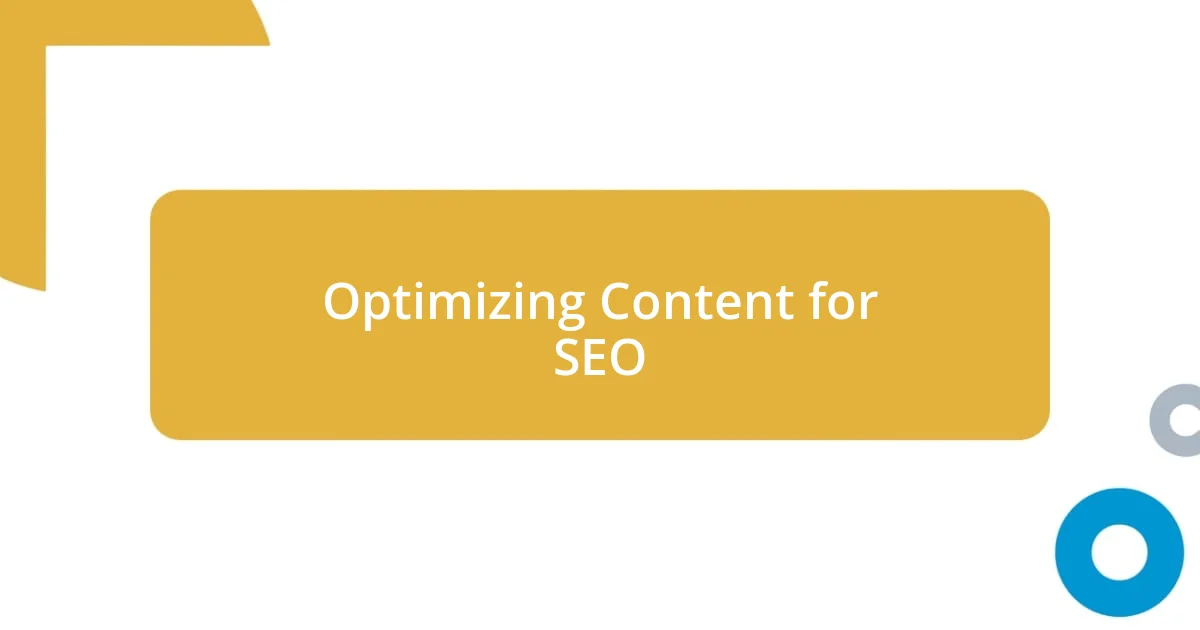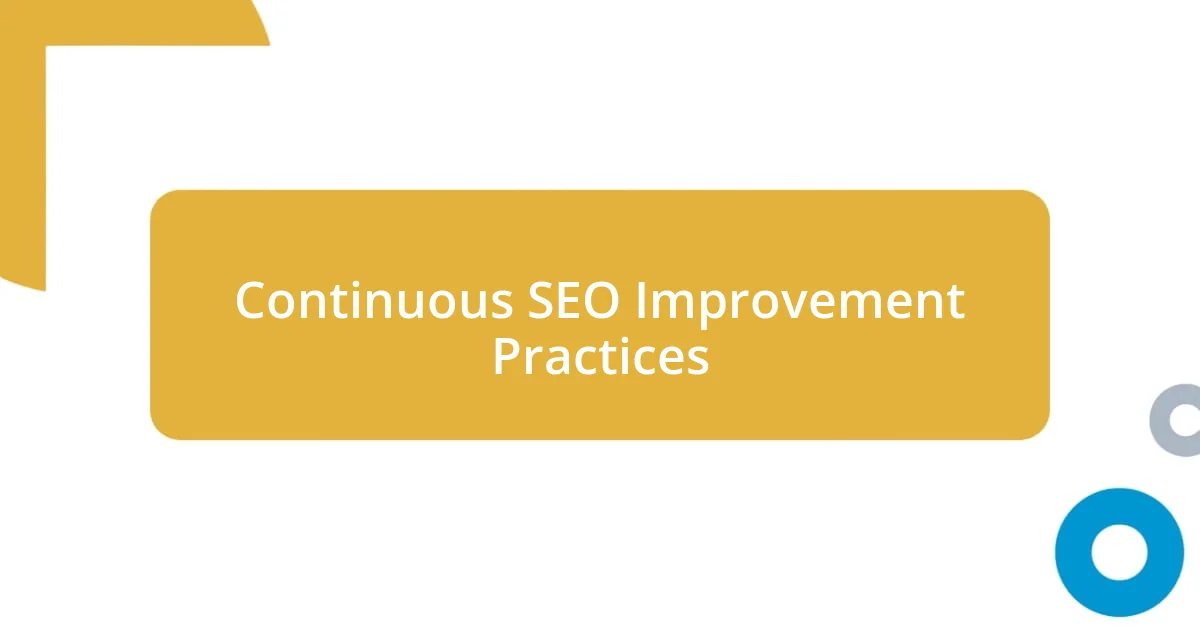Key takeaways:
- Understanding SEO fundamentals, including audience needs and search engine algorithms, can significantly enhance content visibility and user engagement.
- Utilizing effective keyword research techniques, such as Google Keyword Planner and analyzing competitor keywords, is essential for developing a targeted content strategy.
- Continuous improvement in SEO, through updating content, staying informed on trends, and soliciting audience feedback, fosters long-term growth and engagement.

Understanding SEO Basics
Understanding the basics of SEO is crucial for anyone hoping to enhance their online presence. I remember my first experience diving into SEO; I was overwhelmed by the technical jargon and the sheer volume of information out there. But it quickly became clear that SEO isn’t just about keywords; it involves understanding how search engines work and what users are looking for online.
At its core, SEO involves optimizing your content to help search engines connect users with what they need. Have you ever wondered why certain sites pop up at the top of search results? It all relates to the strategies used to align content with search engine algorithms. I once tweaked a blog post by integrating relevant keywords and improving its structure, which ultimately landed it on the first page of Google. The boost in traffic was exhilarating and opened my eyes to the power of SEO.
One essential aspect of SEO is understanding your audience. What questions do they have? What problems are they trying to solve? This perspective shifted my approach dramatically. Instead of merely focusing on what I wanted to say, I began to craft content that directly addressed my readers’ needs, which significantly improved engagement and shareability.

Keyword Research Techniques
When it comes to keyword research techniques, a variety of methods can help uncover valuable insights. I often find myself using tools like Google Keyword Planner and SEMrush. These platforms not only provide keyword suggestions but also show trends over time, helping me gauge potential traffic. I remember discovering a less competitive keyword that turned into a steady traffic source for my blog; it was a game changer for my content strategy.
Another technique I enjoy is analyzing competitor keywords. By looking at the keywords my competitors rank for, I can identify gaps in my own content. Just last month, I realized that a competitor was thriving on a keyword I hadn’t considered. This discovery inspired me to craft a post that directly addressed that topic, and the increased engagement confirmed that I was on the right track.
Lastly, understanding user intent is key in keyword research. I ask myself, “What are users really looking for when they type in that keyword?” This reflection leads to deeper content creation that resonates with readers. I recently published an article that addressed a particular pain point for my audience, and the response was overwhelmingly positive. Tailoring content to answer specific queries not only enhances SEO but also builds trust with my audience.
| Keyword Research Technique | Description |
|---|---|
| Google Keyword Planner | A tool that provides keyword suggestions and traffic estimates. |
| Competitor Analysis | Examining what keywords competitors are ranking for to identify content gaps. |
| User Intent Understanding | Determining what users intend to find when they search for specific keywords. |

Optimizing Content for SEO
When it comes to optimizing content for SEO, I believe that the foundation lies in clear structure and user experience. A well-organized article not only enhances readability but also guides search engines through the content. I recall a time when I revamped a long, cluttered blog post by breaking it into sections with clear headers. Not only did this improve user engagement, but I noticed a significant rise in time spent on the page. It felt rewarding to see hard work translate into results.
In my experience, effective on-page optimization includes using title tags, meta descriptions, and alt text for images. These elements serve as signposts for both readers and search engines, clarifying what the content is about. Here are key factors I focus on:
- Title Tags: Craft compelling titles that include primary keywords and entice clicks.
- Meta Descriptions: Write concise summaries that accurately reflect the article’s content and utilize relevant keywords.
- Header Tags: Use headers (H1, H2, H3) not just for hierarchy but also to naturally embed keywords.
- Alt Text for Images: Provide descriptive text for images, which helps search engines understand the context and improves accessibility.
- Internal Linking: Link to related posts within your site; it enhances navigation and keeps readers exploring.
I’ve found that keeping these optimization techniques in mind not only boosts visibility but also enriches the user’s journey through my content. Ultimately, it’s about creating a seamless experience that benefits everyone involved.

Utilizing On-Page SEO Strategies
I see on-page SEO strategies as a crucial gateway for enhancing both visibility and user experience. One of my go-to methods is optimizing header tags effectively. I remember working on a lengthy guide where I strategically used H2 and H3 tags to break down complex topics. This not only made the content user-friendly but also helped search engines better understand the key points. Have you ever clicked on a post only to find it overwhelming? That’s precisely what I aim to avoid with clear headers.
Another powerful strategy I’ve adopted is the use of internal links. I love weaving related articles throughout my content like breadcrumbs that guide readers to more valuable insights. For instance, in a recent blog post about productivity tips, I linked to other articles that dive deeper into specific techniques. This not only kept my audience engaged longer but also improved my site’s overall SEO. Isn’t it satisfying when readers linger a bit longer, exploring everything you have to offer?
Don’t overlook the importance of image optimization. I always ensure that my images include alt text that describes the visuals while integrating relevant keywords. There was a time I neglected this, and it felt like a missed opportunity when I didn’t see the pages ranking as expected. Once I incorporated alt texts, I noticed a gradual increase in search rankings and site accessibility. Isn’t it fascinating how a little adjustment can create significant shifts in performance?

Implementing Internal and External Links
When implementing internal and external links, I always think about the bigger picture of creating a connected web of information. A while back, I published an article on healthy eating and intentionally linked to previous discussions on meal prep and nutrition basics. I felt a surge of satisfaction when my readers complimented how those links made it easier to explore related content. It’s not just about keeping readers on my site; it’s about providing them a valuable pathway to dive deeper into topics they care about. Have you ever found yourself stumbling onto a rabbit hole of knowledge through well-placed links?
On the flip side, external linking is just as essential. I make it a point to reference credible sources that support my claims or provide additional context. For instance, in a post discussing the benefits of meditation, I linked to peer-reviewed studies that highlighted its effects on mental health. This not only lends authority to my content but also positions me as a trusted resource. I remember the feeling of joy when I received feedback from peers appreciating the linkage, making me realize how much it resonates when we share knowledge.
I also always pay attention to the balance of my links. Too many external links can lead readers away, while too few might make my content feel insular. I once published a piece brimming with internal links and noticed my engagement metrics soar because readers ended up exploring related ideas. It was like a little community blossoming after I opened the doors with strategic linking. Isn’t it incredible how small adjustments in our linking strategy can lead to significant improvements in engagement and trust?

Measuring SEO Performance and Results
Measuring SEO performance is all about understanding what works and what doesn’t in my content strategy. I regularly check analytics tools like Google Analytics and SEMrush, which provide metrics such as organic traffic and bounce rates. I can vividly recall reviewing a blog post that initially saw low traffic; after tweaking my keywords and revisiting my meta descriptions, the numbers surged. Isn’t it rewarding to witness those numbers climb when you apply what you’ve learned?
I also pay a lot of attention to keyword rankings. Monitoring where my content stands for targeted keywords gives me insights into my SEO health. There was a time when I focused on a specific keyword like “content marketing strategies.” Initially, I was nowhere near the first page. After a few adjustments in my strategy, I proudly saw my content not just appear on the first page, but even in the featured snippet! Have you ever felt that thrill when your hard work finally gets recognized?
Lastly, I take special note of user engagement metrics. Tools like Hotjar allow me to see how visitors navigate through my content. There was one occasion where I noticed users frequently dropping off midway through a particular post. By addressing the layout and breaking up the text with visuals, I turned that post into one of my most engaging pieces. Isn’t it fascinating how small changes can lead to significant improvements in interaction and retention?

Continuous SEO Improvement Practices
Continuous SEO improvement is like nurturing a garden; it requires regular attention and adaptation. I often revisit my past posts to identify keywords that may need refreshing. One time, I stumbled across an old article that was still relevant but lacked updated information. After integrating fresh data and optimizing my keywords, I was pleasantly surprised to see a noticeable increase in traffic. Have you ever gone back to old content and found it was a goldmine waiting to be uncovered?
Keeping abreast of SEO trends is also crucial in my ongoing journey. I follow reputable blogs and industry leaders to stay updated on changing algorithms and best practices. For instance, after a major Google update focused on user experience, I dedicated a weekend to optimizing site speed for my blog. The result? My page views doubled. It almost feels like being on a constant learning curve—how do you ensure you’re not getting left behind?
Soliciting feedback is another vital practice I embrace. Occasionally, I reach out to my audience for their thoughts on my content. I once created a brief survey, asking readers which topics they found most valuable or what they wished I had covered. The insights I gathered reshaped my content direction completely and led to my most successful series to date. Isn’t it amazing how listening to your audience can open up new avenues for growth?














